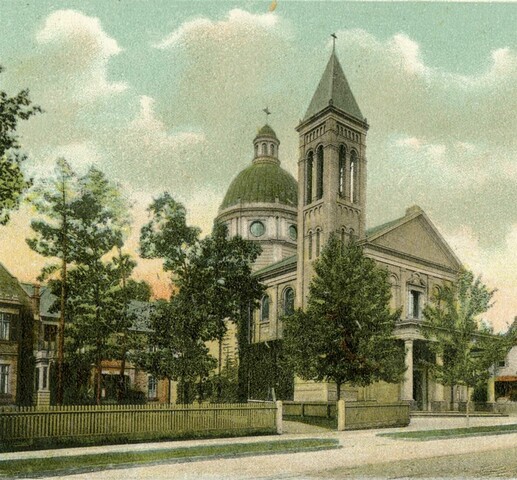
St. James Town: Our Lady of Lourdes Catholic Church
Our Lady of Lourdes Catholic Church
520 Sherbourne Street
Church of Our Lady of Lourdes, Sherbourne Street. 1910. Illustration by American News Company. Courtesy of the Toronto Public Library.
Our Lady of Lourdes Roman Catholic Church on Sherbourne Street, 1972. City of Toronto Archives. Fonds 2032, Series 841, File 7, Item 10.
Filipino youth celebrating Christmas at Silayan Center, Toronto, Date Unknown. MHSOFI1-11867-2.
Our Lady of Lourdes Catholic Church, St. James Town. August 15, 2021.
St. John’s Grove
Our Lady of Lourdes Catholic Church was built as a gift from the clergy of the Archdiocese to the Most Reverend John Joseph Lynch, D.D., the first Roman Catholic Archbishop of Toronto. The lands surrounding the church were formerly known as St. John’s Grove in the 19th century; it was also the site of the Archbishop’s summer residence and contained a grotto honouring Our Lady of Lourdes since 1876.
Italian-inspired architecture
Architect Frederick Charles Law modelled Our Lady of Lourdes after the Parish Basilica of Santa Maria del Popolo in Rome, which featured a cross-shaped basilica, octagonal dome, and slim bell tower. When it opened in October 1886, Our Lady of Lourdes was the only church to feature a dome in Toronto. The church was modified in 1910 to incorporate the former archdiocesan residence, which previously sat to the south of the church.
A growing community
Following the redevelopment of the St. James Town neighbourhood in the 1960s and 1970s, the ample housing in the area attracted several newcomer communities, including the Filipino community. During this period, the Filipino community was one of the fastest growing in Toronto: from a small group of less than 100 in 1965 to over 30,000 by 1977. Our Lady of Lourdes Church became an important focal point for the community: providing space for social groups such as the “Circulo Ilongo,” which hosted meetings as well as service-based activities in the Church’s basement.
A thriving community space
Our Lady of Lourdes Church also provided meeting space for Toronto’s first Filipino community centre, known as the Silayan Community Centre, from the Tagalog word “Silayan” meaning “new dawn.” Opened in the early 1970s, the Centre aimed to meet the social, religious, and practical needs of the city’s Filipino population. The Silayan Centre eventually moved to its own space at 495 Parliament Street, and continues to offer resources to Filipino newcomers today.
Further Reading
-“Aid Centre set up to assist Filipinos adjust to Canadian life,” The Toronto Star (September 4, 1971), p. 6
-Rosalina Bustamente, ‘A Growing Community in Fast Growing City’ Polyphony: Toronto’s People, Vol. 6, (Multicultural History Society of Ontario, 1984), pg. 168-171.
-Robert Cusipag, Portrait of Filipino Canadians in Ontario: 1960-1990, (Kalayan Media, 1993).
-Joe Serge, “Busy Toronto new lifestyle for Filipinos,” The Toronto Star (March 28, 1977), p. D1

